Wyoming is not for the weak when it comes to people or animals. Wyoming has vast stretches of very rugged terrain. There are several large national parks in Wyoming including Yellowstone, which was the first national park in the U.S. Wyoming has the Rocky Mountains, large swaths of grass plains, and the Red Desert, which is the largest living dune system in the U.S. The large open grasslands, deserts, and mountains are the ideal habitats for many different types of snakes. Most of the snakes that you might find in Wyoming are not venomous. However, always keep an eye out for snakes when you are exploring open land like Wyoming.
Types of Snakes
There are 14 different types of snakes that are native to Wyoming, and 11 of them are not venomous. Still, any snake can strike out or bite if startled or threatened. When you’re hiking, camping, or exploring national parks in Wyoming you should wear long pants, keep the tops of your pants inside your boots, and watch the ground in front of you and to the sides of you. You just might see one of these snakes:
Rubber Boa (Charina bottae)
Rubber boa snakes like hot habitats where there are rocks to sun on. They very much enjoy hot sunny weather but hide from humans. So if you’re hiking in the Red Desert and there is a rubber boa snake nearby you may not even know it. Typically rubber boas stay small at just about a foot to a foot and a half long. But they are wide solidly built snakes even though they are short. These snakes have smooth scales and a uniform gray or tan color that helps them blend into their surroundings. They will appear shiny though, like rubber.

Rubber boa snakes like hot habitats where there are rocks to sun on.
©yhelfman/Shutterstock.com
Yellow-Bellied North American Racer (Coluber constrictor flaviventris)
There are several subspecies of racer snakes, all based on color or locality. They’re not all black; they can be green, blue, and even pinkish/red. The most common racer in Wyoming is the yellow-bellied (Coluber constrictor flaviventris). The racers are fast-moving, highly active snakes. They are often found near water, but also in brush, trash piles, roadsides, and swamps. Adult racers can typically be 20 inches to 60 inches in total length, depending on the subspecies. A typical adult will weigh around 556 g or 1.226 lb, with little size difference between females and males.
Their diet consists primarily of small rodents, other mammals, frogs, lizards, and other snakes. Some subspecies are known to climb trees to eat eggs and young birds. Despite part of their species name constrictor, they do not actually employ constriction but instead subdue struggling prey by pinning it bodily to hold it in place instead of suffocating it.
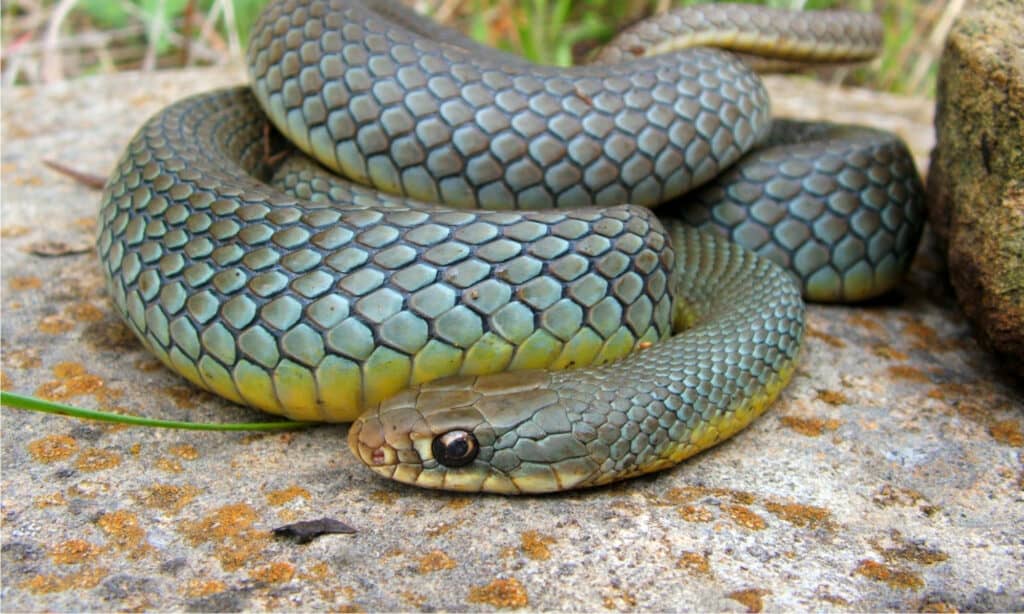
A large and colorful Eastern Yellow-bellied Racer snake coils defensively with a large meal in its belly.
©Matt Jeppson/Shutterstock.com
Red-Sided Garter Snake (Thamnophis sirtalis parietalis)
The red-sided garter snake is one of the many different types of garter snakes. This particular snake is not common though. You will only see the red-sided garter snake in eastern Wyoming and California. This garter snake is colorful and has a base color of tan or olive with bright red stripes on the side and down the center of the back. There are also usually some black and red squares on the belly of this snake. Sometimes the stripes can be blue or yellow. The red-sided garter snake is usually only about three feet long.
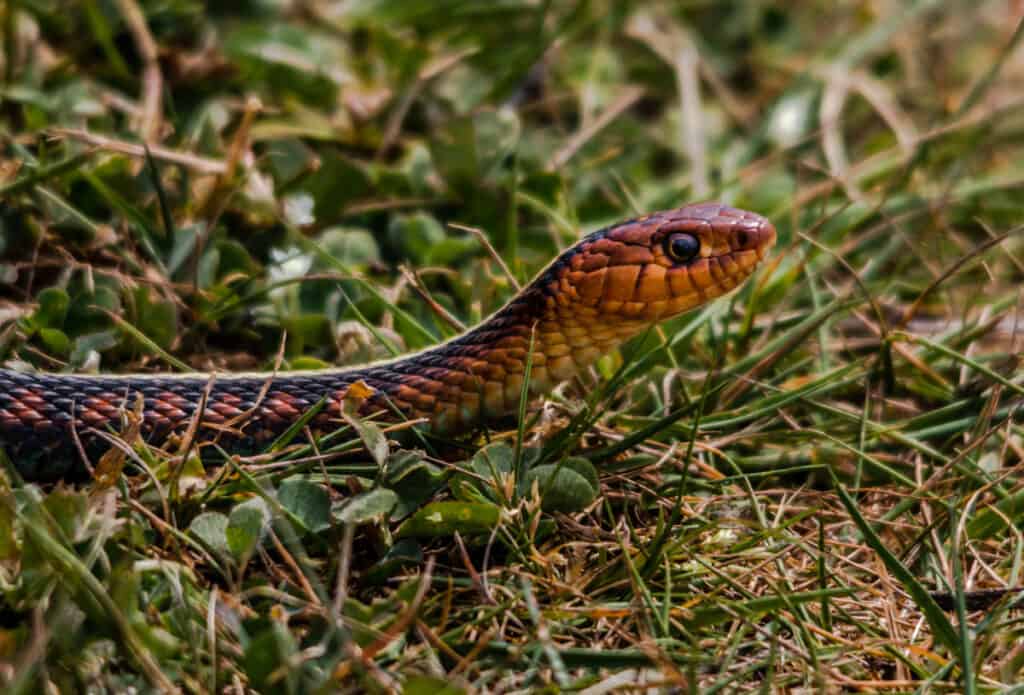
You will only see the red-sided garter snake in eastern Wyoming and California.
©iStock.com/raywhittemore
Smooth Green Snake (Opheodrys vernalis)
Smooth green snakes prefer woodland areas that are wet and grassy, but they can do quite well in a wide range of environments. That’s one of the reasons why they can be found throughout Wyoming and in many other states. These snakes are bright green, which helps them hide among the forest vegetation. They are not very large and usually are just over a foot long. Their scales give them a very smooth and even appearance which is why they are called smooth green snakes. There is another type of snake called a rough green snake which has scaled that give it a textured look. If you see a bright green snake that looks shiny like glass that’s a smooth green snake.
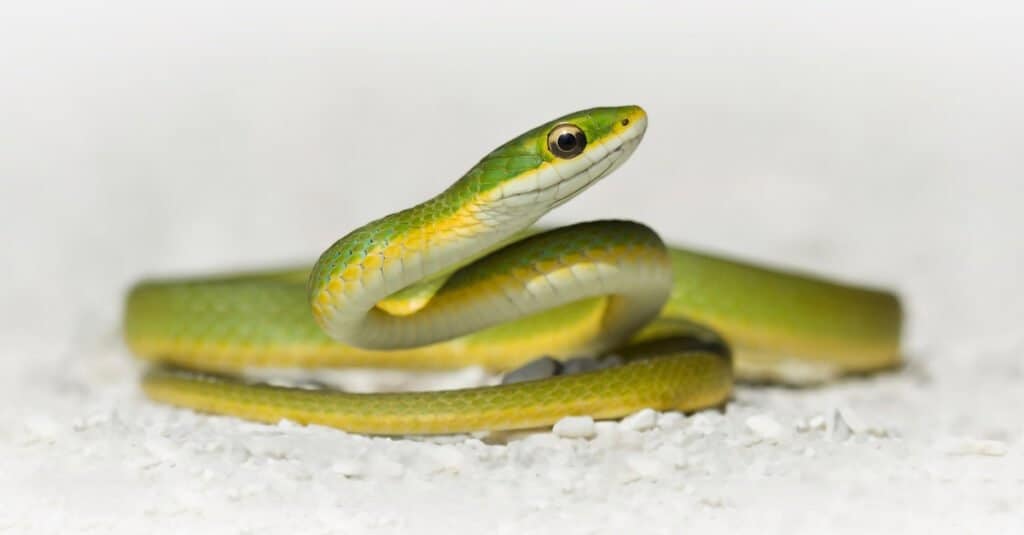
Smooth green snakes prefer woodland areas that are wet and grassy, but they can do quite well in a wide range of environments. That’s one of the reasons why they can be found throughout Wyoming.
©Kristian Bell/Shutterstock.com
Pale Milksnake (Lampropeltis triangulum multistriata)
Pale Milksnakes are primarily nocturnal and are very secretive. During the day, this species is often hidden under cover. Milksnakes are usually observed in the open on humid nights or after rains. This species may hibernate communally with other species of snakes. They prefer woodlands of the plains and foothills, in the prairies, sandhills, shrubby hillsides, canyons, juniper woodlands, and arid river valleys. They also can be found in dry conifer forests in mountain areas. They are considered vulnerable due to restricted numbers in the state of Wyoming.
These snakes are known for their body and tail color pattern consisting of rings or blotches involving the following sequence starting from the nape. They grow to be between 16 inches and 32 inches long.
Bullsnake (Pituophis catenifer sayi)
Subspecies of the gopher snake, the bullsnake likes the Great Plains and the Midwestern United States. They are often yellowish or pale brown with large, dark brown or black blotches and smaller, dark spots on the sides. These snakes can be anywhere from 3 feet to 8 feet long, making it one of the longest in North America. Bullsnakes can be mistaken for the prairie rattlesnake but it lacks the black and white banding on its tail and has a narrower head than a rattlesnake. Not for nothing, the bullsnake engages in mimicry, puffing up and curling into a rattlesnake strike pose, and even attempting to strike, though with its mouth closed. It also is known for hitting its tail on the ground in a rattlesnake-like manner. However, these snakes are no threat to humans.

When threatened, the Bullsnake rears up in an S-shape, hisses, and vibrates its tail to mimic the venomous rattlesnake.
©iStock.com/92968526
Desert Striped Whip Snake (Masticophis taeniatus taeniatus)
The desert striped whip snake is typically found in sagebrush areas and flat lands but it can also be found in the mountains like the Rocky Mountain region of Wyoming. You will also see these snakes in Grand Teton National Park. Desert striped whip snakes are not longer than six feet long and they are very thin. They are called whip snakes because when they are coiled up they look like a coiled whip because they are long and thin. Most of the time these snakes are dark olive to dark tan with cream or yellow stripes running down the sides of the entire length of the snake. They may have some red or pinkish red on their tail.
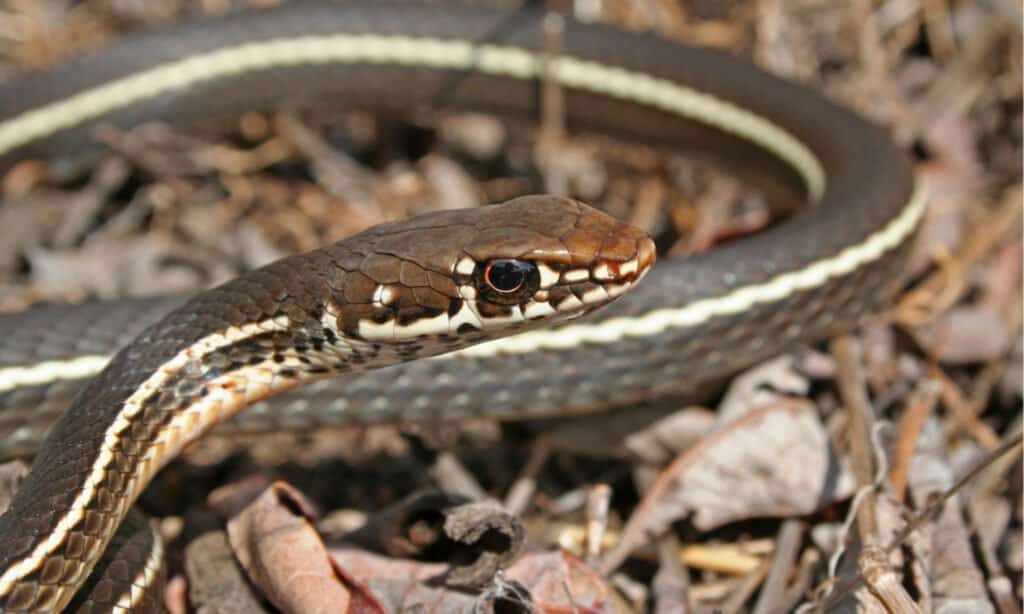
Desert Striped Whip Snakes can be found in the Rocky Mountain region of Wyoming and also in the Grand Teton National Park.
©Creeping Things/Shutterstock.com
Plains Hognose Snake (Heterodon nasicus)
You can always tell a plains hognose snake (or western hognose) by its snout. These snakes have an unmistakable upturned snout that they use to dig in loose, dry, sandy soil. In the Red Desert, you will often see plains hognose snakes crossing trails and burrowing into the sandy dry soil. These snakes can resemble venomous cottonmouth snakes but cottonmouths are water snakes. There are no cottonmouth snakes in Wyoming. There are only three types of venomous snakes in Wyoming and they are all rattlesnakes. So don’t let the western hognose snake scare you because it won’t hurt you.
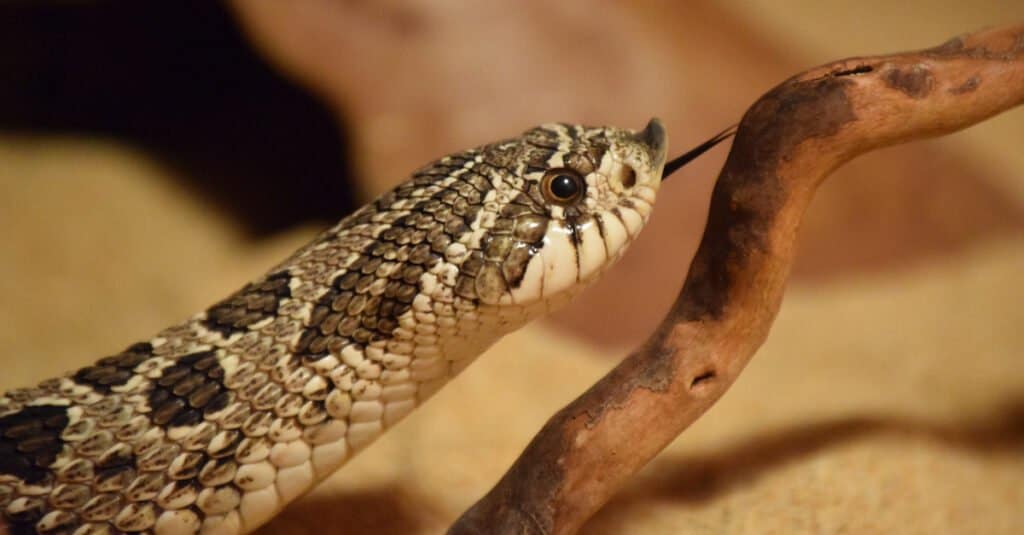
In the Red Desert, you will often see plains hognose snakes crossing trails and burrowing into the sandy dry soil.
©Bryn Thomas/Shutterstock.com
Black Hills Red-Bellied Snake (Storeria occipitomaculata pahasapae)
Normally brown to russet on its body, the belly of the Black Hills red-bellied snake is usually a red-orange but may rarely be gray or black. They like moist habitats including riparian woodlands, deciduous forests, wet meadows, and residential areas. Though you might fear them, these snakes are docile and rarely bite. Instead of striking, they flatten out their bodies to make themselves appear larger, curl their lips, and release a foul-smelling musk when threatened. Some have been reported to feign death and expose their red undersides instead. Adults range from 10 inches to 12 inches in length.
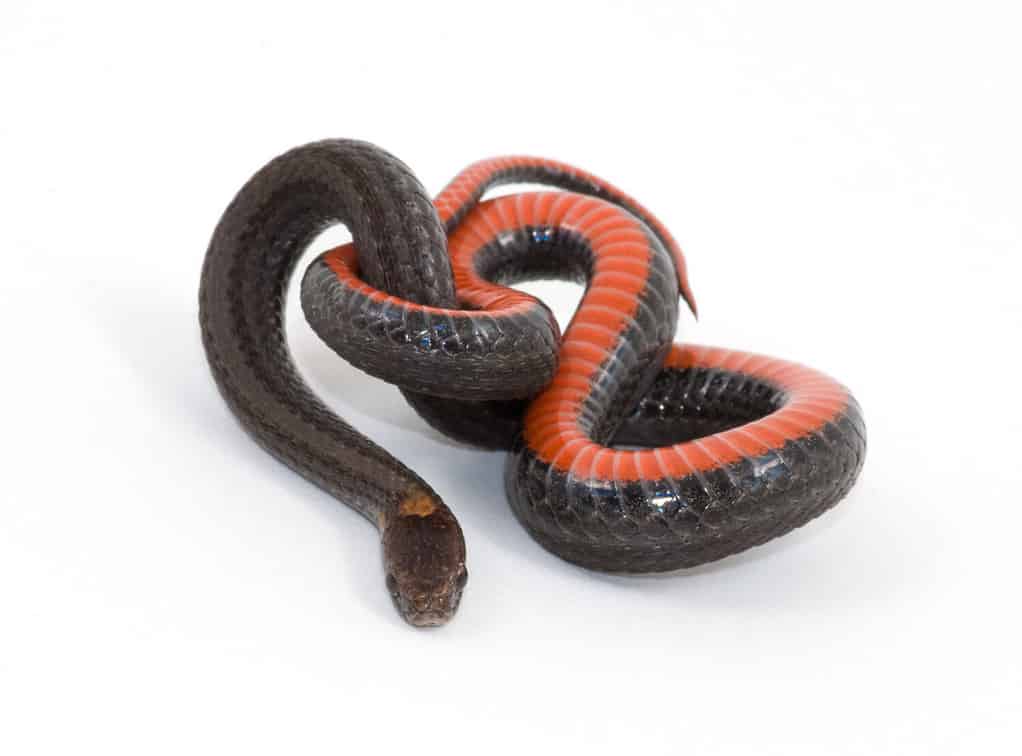
Though you might fear them, the Black Hills red-bellied snakes are docile and rarely bite.
©Gerald A. DeBoer/Shutterstock.com
Western Terrestrial Garter Snake (Thamnophis elegans)
Most western terrestrial garter snakes have a yellow, light orange, or white dorsal stripe, accompanied by two stripes of the same color, one on each side. They are medium-sized snakes, usually 18 inches to 41 inches in length. This species, the western terrestrial, is the only garter snake species with a well-documented tendency to constrict prey, though it’s an ineffective method for this type of snake compared to others. As far as habitat, they like grasslands, woodlands, and coniferous forests.
This species has a very mildly neurotoxic venom. However, they don’t pose a threat to people as they cannot effectively deliver the venom to anything but small prey.
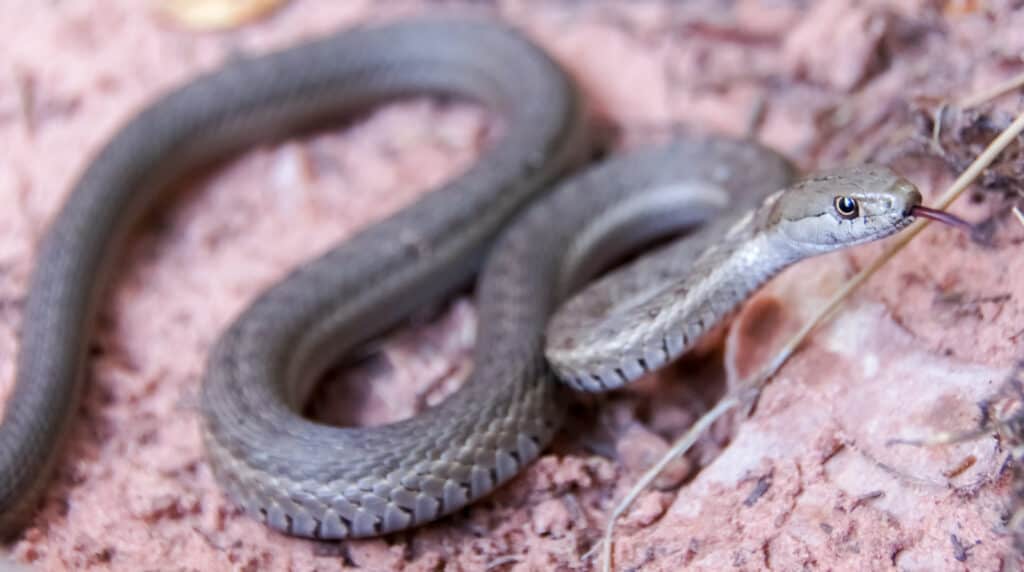
Western Terrestrial Garter Snake has very mildly neurotoxic venom, but it doesn’t affect humans.
©iStock.com/yhelfman
Plains Garter Snake (Thamnophis radix)
The plains garter snake has a distinctive orange or yellow stripe from its head to tail, and the rest of its body is mainly a gray-green color.
This species is often found near water sources, such as marshes, streams, and ponds, well as prairies. It also likes cities, housing itself in vacant lots and buildings. Their prey usually consists of amphibians and small rodents. The snake is described as medium-sized and is on average about 36 inches. It is considered a special concern in the state of Wyoming, even if its overall considered least concerned as far as species endangerment.
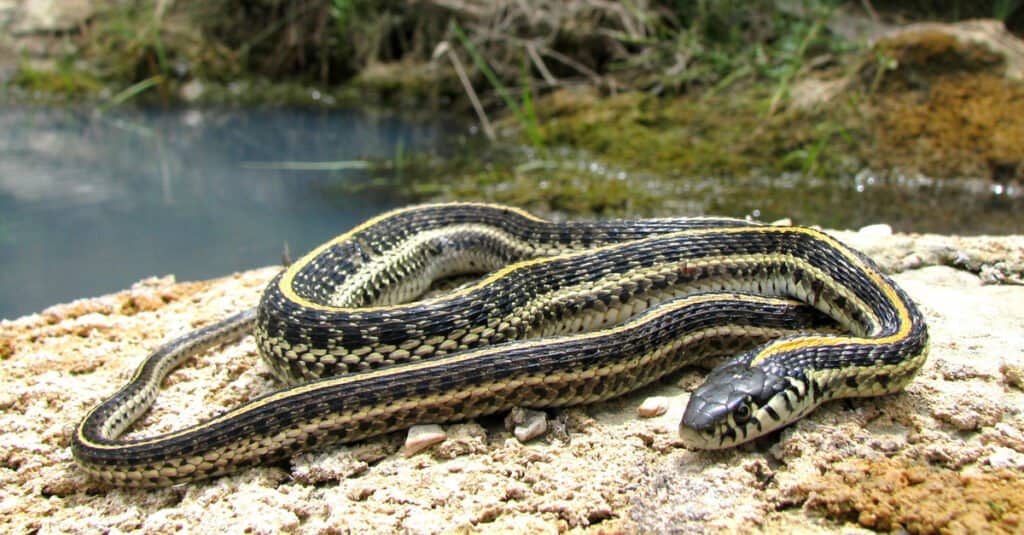
The plains garter snake is often found near water sources.
©Joe Farah/Shutterstock.com
Venomous Snakes In Wyoming
Wyoming has three different kinds of venomous snakes, which is less than some other states but the venomous snakes in Wyoming are snakes that aren’t common even in other states. The venomous snakes in Wyoming are:
Great Basin Rattlesnake (Crotalus lutosis)
Measuring between 26 and 49 inches long, this deadly snake appears gray, brown, olive, or yellow with brown or black splotches. Great Basin rattlesnakes live in dry, barren habitats that feature plenty of rocks and boulders for them to hide under.
Their diet consists of small birds, reptiles, amphibians, and mammals. People often encounter them when hiking on trails in western Wyoming.
When threatened, they may shake their tails, which produces a distinctive rattling sound. Don’t stick around if you hear their rattle; the venom of the Great Basin rattlesnake is complex, with myotoxins, hemotoxins, and possibly neurotoxins.
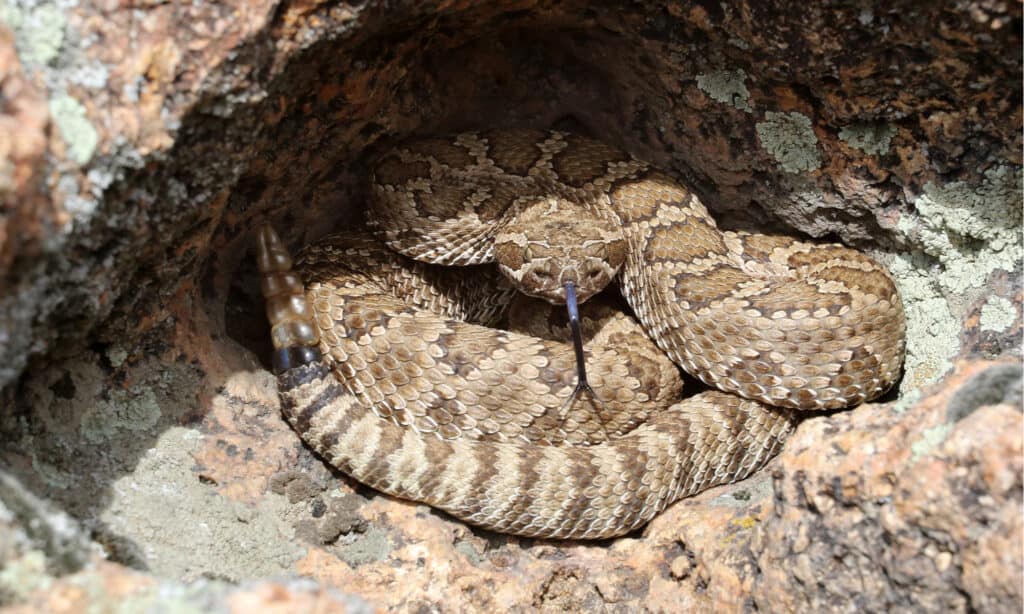
Great Basin rattlesnakes live in dry, barren habitats that feature plenty of rocks and boulders for them to hide.
©Randy Bjorklund/Shutterstock.com
Midget Faded Rattlesnake (Crotalus concolor)
As you may have guessed from the name the midget faded rattlesnake is quite small. Most of these snakes are less than two feet long. But what they lack in size they make up for in potency. A bite from a faded midget rattlesnake is very serious and requires immediate medical intervention. As the venom works its way through the body it will destroy red blood cells which can cause your tissue to die. Faded midget rattlesnakes are usually a very pale tan or pale brown with light markings.
When you are hiking or camping in Wyoming, especially in the Red Desert area and in the national parks, always be watching and listening for rattlesnakes. Walk extremely carefully and deliberately and be sure of where you putting your feet each time you take a step.
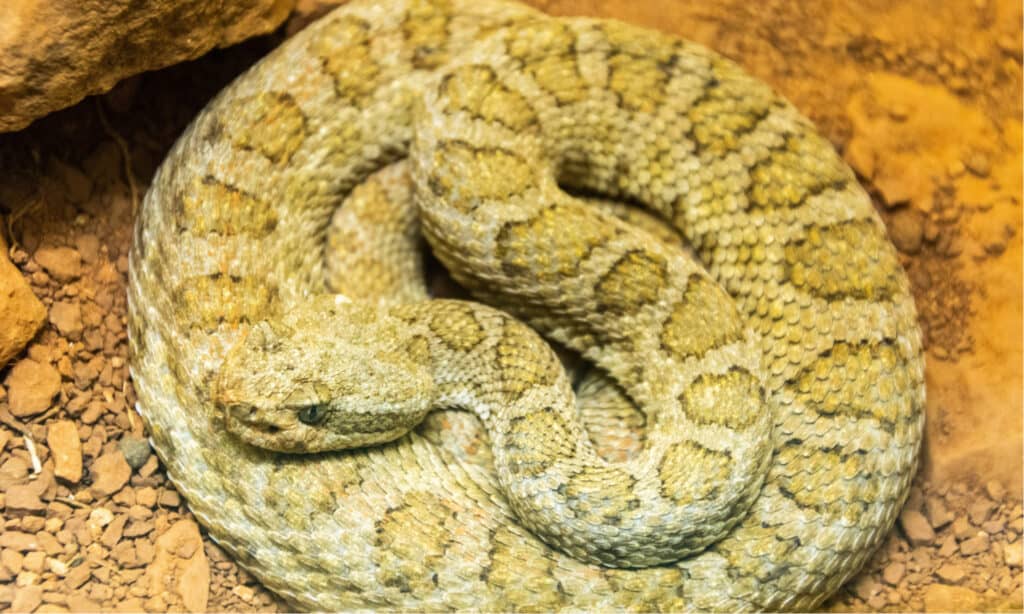
This species has a couple of nasty toxins, one attacks the nervous system, and the other attacks muscle tissue.
©Alizada Studios/Shutterstock.com
Prairie Rattlesnake (Crotalus viridis)
Sometimes called the Great Plains rattlesnake, the prairie rattlesnake range covers most of the Great Plains area of North America, southwestern Canada, and northern Mexico. Prairie rattlesnakes are usually more than 3 feet long but can measure anywhere from 35-45 inches.
It is lightly colored, usually in various shades of brown, with dark brown oval-shaped patches with thin white borders running down the middle of its back. The scales along its back are also keeled, so there is a rough ridge in the middle of each scale, giving the snake a rougher, bristly appearance.
Prairie rattlesnakes primarily eat small mammals like mice, ground squirrels, small rabbits, prairie dogs, and rats. The venom of the prairie rattlesnake is primarily a hemotoxin, destroying red blood cells, but it also has some neurotoxic elements that can interfere with cell signaling and cause paralysis.
In a surprising fact, all prairie rattlesnakes have toxic venom from the day they are born, although some scientists argue that the venom composition changes as they age.

Prairie rattlesnakes possibly have venom from the day they are born.
©DMartin09/Shutterstock.com
Summary of 14 Snakes In Wyoming
| Rank | Snake |
|---|---|
| 1 | Rubber Boa |
| 2 | Yellow-Bellied North American Racer |
| 3 | Red-Sided Garter Snake |
| 4 | Smooth Green Snake |
| 5 | Pale Milksnake |
| 6 | Bullsnake |
| 7 | Desert Striped Whip Snake |
| 8 | Plains Hognose Snake |
| 9 | Black Hills Red-Bellied Snake |
| 10 | Western Terrestrial Garter Snake |
| 11 | Plains Garter Snake |
| 12 | Great Basin Rattlesnake |
| 13 | Midget Faded Rattlesnake |
| 14 | Prairie Rattlesnake |
The photo featured at the top of this post is © Tom Reichner/Shutterstock.com
Discover the "Monster" Snake 5X Bigger than an Anaconda
Every day A-Z Animals sends out some of the most incredible facts in the world from our free newsletter. Want to discover the 10 most beautiful snakes in the world, a "snake island" where you're never more than 3 feet from danger, or a "monster" snake 5X larger than an anaconda? Then sign up right now and you'll start receiving our daily newsletter absolutely free.
FAQs (Frequently Asked Questions)
Is the Western Hognose a venemous snake?
No. These snakes can resemble venomous cottonmouth snakes but cottonmouths are water snakes and the western hognose is neither venomous nor a water snake.
Why should I be aware of the trees and shrubs and not just the ground when outdoors in Wyoming?
One of the characteristics of western rattlesnakes is that they can climb into shrubs, bushes and trees.
What was the first national park?
Yellowstone National Park is the first national park created and it is located in Wyoming.
Thank you for reading! Have some feedback for us? Contact the AZ Animals editorial team.






